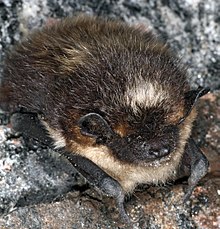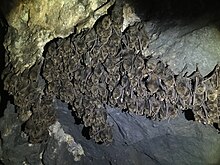
Back Hibernasie Afrikaans Winterschlaf ALS سبات شتوي Arabic Спячка Byelorussian Хибернация Bulgarian শীতনিদ্রা Bengali/Bangla Hibernacija BS Hibernació Catalan سڕبوونی زستانە CKB Hibernace Czech


Hibernation is a state of minimal activity and metabolic depression undergone by some animal species. Hibernation is a seasonal heterothermy characterized by low body-temperature, slow breathing and heart-rate, and low metabolic rate. It most commonly occurs during winter months.
Although traditionally reserved for "deep" hibernators such as rodents, the term has been redefined to include animals such as bears[1] and is now applied based on active metabolic suppression rather than any absolute decline in body temperature. Many experts believe that the processes of daily torpor and hibernation form a continuum and utilise similar mechanisms.[2][3] The equivalent during the summer months is aestivation.
Hibernation functions to conserve energy when sufficient food is not available. To achieve this energy saving, an endothermic animal decreases its metabolic rate and thereby its body temperature.[3] Hibernation may last days, weeks, or months—depending on the species, ambient temperature, time of year, and the individual's body-condition. Before entering hibernation, animals need to store enough energy to last through the duration of their dormant period, possibly as long as an entire winter. Larger species become hyperphagic, eating a large amount of food and storing the energy in their bodies in the form of fat deposits. In many small species, food caching replaces eating and becoming fat.[4]
Some species of mammals hibernate while gestating young, which are born either while the mother hibernates or shortly afterwards.[5] For example, female black bears go into hibernation during the winter months in order to give birth to their offspring.[6] The pregnant mothers significantly increase their body mass prior to hibernation, and this increase is further reflected in the weight of the offspring. The fat accumulation enables them to provide a sufficiently warm and nurturing environment for their newborns. During hibernation, they subsequently lose 15–27% of their pre-hibernation weight by using their stored fats for energy.[7]
Ectothermic animals also undergo periods of metabolic suppression and dormancy, which in many invertebrates is referred to as diapause. Some researchers and members of the public use the term brumate to describe winter dormancy of reptiles, but the more general term hibernation is believed adequate to refer to any winter dormancy.[8] Many insects, such as the wasp Polistes exclamans and the beetle Bolitotherus, exhibit periods of dormancy which have often been referred to as hibernation, despite their ectothermy.[9] Botanists may use the term "seed hibernation" to refer to a form of seed dormancy.[10]
| Part of a series on |
| Animal dormancy |
|---|
 |
- ^ "Do Black Bears Hibernate?". North American Bear Center. 2008-01-28. Retrieved 12 October 2019.
- ^ Watts PD, Oritsland NA, Jonkel C, Ronald K (1981). "Mammalian hibernation and the oxygen consumption of a denning black bear (Ursus americanus)". Comparative Biochemistry and Physiology A. 69 (1): 121–3. doi:10.1016/0300-9629(81)90645-9.
- ^ a b Geiser, Fritz (2004). "Metabolic Rate and Body Temperature Reduction During Hibernation and Daily Torpor". Annual Review of Physiology. 66: 239–274. doi:10.1146/annurev.physiol.66.032102.115105. PMID 14977403. S2CID 22397415.
- ^ Humphries, M. M.; Thomas, D.W.; Kramer, D.L. (2003). "The role of energy availability in mammalian hibernation: A cost-benefit approach". Physiological and Biochemical Zoology. 76 (2): 165–179. doi:10.1086/367950. PMID 12794670. S2CID 14675451.
- ^ Hellgren, Eric C. (1998). "Physiology of Hibernation in Bears" (PDF). Ursus. 10: 467–477. JSTOR 3873159. Archived from the original (PDF) on 2016-09-08. Retrieved 2017-01-06.
- ^ DeMaster, Douglas P.; Stirling, Ian (1981-05-08). "Ursus maritimus". Mammalian Species (145): 1–7. doi:10.2307/3503828. ISSN 0076-3519. JSTOR 3503828.
- ^ Molnar PK, Derocher AE, Kianjscek T, Lewis MA (2011). "Predicting climate change impacts on polar bear litter size". Nat Commun. 2: 186. Bibcode:2011NatCo...2..186M. doi:10.1038/ncomms1183. PMC 3105343. PMID 21304515.
- ^ Ultsch, Gordon R. 1989. Ecology and Physiology of Hibernation and Overwintering Among Freshwater Fishes, Turtles, and Snakes. Biological Reviews 64(4), pp. 435-515. doi:10.1111/j.1469-185X.1989.tb00683.x
- ^ González, Jorge M.; Vinson, S. Bradleigh (2007). "Does Polistes exclamans Vierek (Hymenoptera: Vespidae) Hibernate Inside Muddauber Nests?". Southwestern Entomologist. 32 (1): 67–71. doi:10.3958/0147-1724-32.1.69. S2CID 84040488.
- ^
Cruzan, Mitchell B. (2018). Evolutionary Biology: A Plant Perspective. New York: Oxford University Press. p. 146. ISBN 9780190882686. Retrieved 21 September 2019.
With the exception of some tropical species, seed germination is typically postponed for some period that is determined by characteristics of seeds and the environmental conditions they are exposed to [...]. [...] seeds may remain ungerminated and persist in the soil for many years. In this case, latency is induced by external environmental conditions, so these seeds are effectively in hibernation. [...] Because of seed hibernation and dormancy, many plant populations consist of adult individuals as well as Seed Banks that may be composed of seeds produced over a number of growing seasons.
© MMXXIII Rich X Search. We shall prevail. All rights reserved. Rich X Search